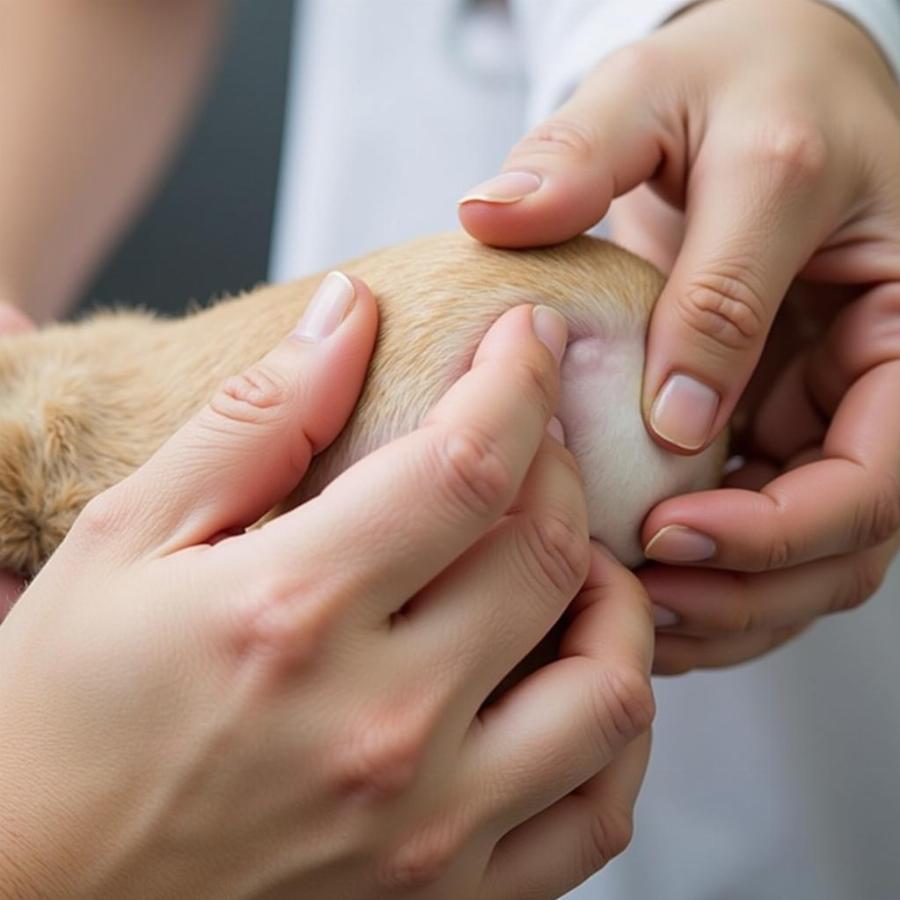Discovering a lump on your beloved canine companion can be a worrisome experience. While many lumps and bumps are benign, it’s essential to be aware of potentially serious conditions, such as fatty tumors that burst. This article will delve into the details of fatty tumors in dogs, helping you understand the causes, symptoms, and treatment options available.
Understanding Fatty Tumors in Dogs
Fatty tumors, also known as lipomas, are the most common type of soft-tissue tumor found in dogs. They originate from fat cells and are typically benign, meaning they don’t spread to other parts of the body.
 A veterinarian examining a fatty tumor on a dog
A veterinarian examining a fatty tumor on a dog
These tumors can vary in size and appearance. While some remain small and barely noticeable, others can grow quite large and potentially cause discomfort or restrict movement.
Causes of Fatty Tumors in Dogs
The exact cause of fatty tumors in dogs is unknown, but several factors may play a role in their development:
- Age: Older dogs are more prone to developing fatty tumors, with the risk increasing significantly after the age of seven.
- Breed Predisposition: Certain breeds, such as Labrador Retrievers, Golden Retrievers, and Beagles, have a higher incidence of fatty tumors.
- Genetics: While not fully understood, genetics likely plays a role in a dog’s susceptibility to developing these tumors.
- Diet and Obesity: Overweight or obese dogs are more likely to develop fatty tumors.
When a Fatty Tumor Bursts
While most fatty tumors are benign and don’t pose serious health risks, there’s a small chance they can rupture. This can happen due to trauma, excessive licking or scratching, or spontaneous rupture in rare cases.
A burst fatty tumor can lead to several complications:
- Bleeding: Ruptured tumors can bleed, sometimes profusely, especially if located in an area with many blood vessels.
- Infection: An open wound from a burst tumor creates an entry point for bacteria, potentially leading to infection.
- Inflammation: The body’s natural response to injury, inflammation can cause swelling, redness, and pain around the affected area.
Symptoms to Watch Out For
Identifying a fatty tumor that has burst requires vigilance and understanding the signs:
- Visible Wound: The most apparent sign is an open sore or wound where the tumor was located.
- Bleeding: You might notice active bleeding or dried blood around the affected area.
- Swelling: Inflammation can cause noticeable swelling around the burst tumor.
- Pain or Discomfort: Your dog might exhibit signs of pain, such as limping, whining, or reluctance to be touched in that area.
- Discharge: A foul-smelling discharge from the wound could indicate an infection.
What to Do if You Suspect a Ruptured Fatty Tumor
If you notice any of the symptoms mentioned above or suspect your dog’s fatty tumor has burst, it’s crucial to seek immediate veterinary attention. Prompt treatment can help prevent infection, manage bleeding, and ensure proper healing.
Treatment Options for Fatty Tumors
The treatment for fatty tumors varies depending on factors such as the tumor’s size, location, and whether it’s causing any problems:
- Monitoring: Small, slow-growing, and asymptomatic fatty tumors might only require regular monitoring by your veterinarian.
- Surgical Removal: If the tumor is large, causing discomfort, or has ruptured, surgical removal is often recommended.
- Fine Needle Aspiration: In some cases, your vet might perform a fine needle aspiration to collect a sample of cells from the tumor for examination under a microscope. This helps confirm the diagnosis and rule out other types of tumors.
Prevention and Long-Term Care
While you can’t entirely prevent fatty tumors in dogs, certain measures can help reduce the risk and promote overall health:
- Maintain a Healthy Weight: Feeding your dog a balanced diet and providing regular exercise can help prevent obesity, a known risk factor for fatty tumors.
- Regular Veterinary Check-ups: Routine checkups allow your vet to detect any lumps or bumps early on and recommend appropriate action.
- Monitor for Changes: Regularly check your dog’s skin for any new growths or changes in existing lumps. If you notice anything unusual, consult your veterinarian.
Fatty Tumors vs. Other Types of Lumps
It’s essential to remember that not all lumps and bumps on dogs are fatty tumors. Several other types of growths can occur, some of which may be malignant (cancerous). Therefore, it’s vital to have any new lump evaluated by a veterinarian to determine its nature and the appropriate course of action.
FAQs About Fatty Tumors in Dogs
Q: Are fatty tumors painful for dogs?
A: Most fatty tumors are not painful. However, larger ones can press on surrounding tissues or become ulcerated, causing discomfort.
Q: Can fatty tumors shrink on their own?
A: Fatty tumors rarely shrink independently.
Q: What is the prognosis for a dog with a fatty tumor?
A: The prognosis for dogs with benign fatty tumors is generally excellent. However, monitoring for changes and seeking veterinary care when needed is crucial.
Q: Is there a way to prevent fatty tumors in dogs?
A: While you can’t completely eliminate the risk, maintaining a healthy weight and providing a balanced diet can help reduce the likelihood of fatty tumors.
Q: What should I do if I find a new lump on my dog?
A: It’s crucial to schedule an appointment with your veterinarian for any new lump or bump found on your dog. They can perform the necessary tests to determine the cause and recommend appropriate treatment.
Need More Help?
If you’re concerned about your furry friend’s health or have any further questions about fatty tumors in dogs, don’t hesitate to reach out to us. At Beaut Dogs, we’re committed to providing pet owners with reliable and accurate information. For personalized advice and support, contact our team at [email protected]. Beaut Dogs is your trusted source for everything related to dog care!